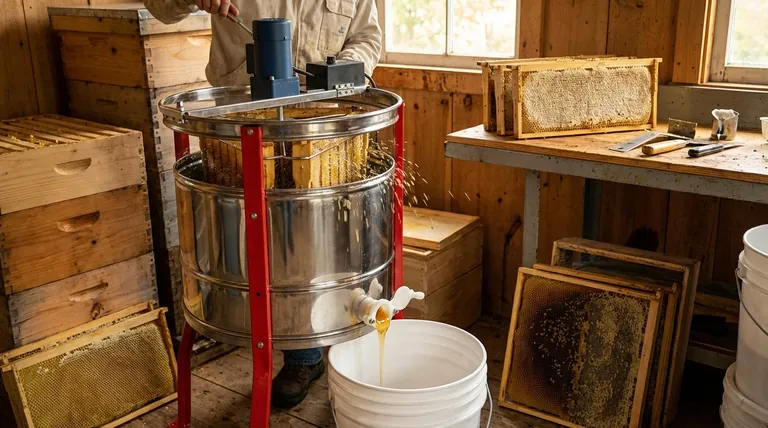In short, a honey extractor is a centrifuge used to remove honey from the comb without destroying it. This device works by spinning frames of honeycomb at high speed, using centrifugal force to pull the honey out and onto the walls of a drum. For beekeepers, its primary benefits are a dramatic increase in harvesting efficiency and the ability to reuse the valuable beeswax comb.
A honey extractor is more than a tool for convenience; it is a strategic investment in the health of your bee colony. By preserving the honeycomb, you save your bees an immense amount of energy, leading to a more resilient and productive hive.

The Core Principle: Preserving the Comb
The most significant advantage of an extractor lies in its ability to keep the honeycomb structure intact. This is far more important than it might initially seem.
Why Comb Preservation is Critical
Bees must consume roughly six to eight pounds of honey to produce just one pound of beeswax. This wax is then meticulously shaped into the perfect hexagonal cells of honeycomb.
Destroying this comb during a harvest forces the colony to expend enormous energy and resources to rebuild it from scratch. By preserving the comb, you allow your bees to redirect that energy toward foraging and raising the next generation.
Reducing Stress on the Colony
Rebuilding an entire hive's worth of comb is a massive undertaking that puts significant stress on the colony.
When you return empty, undamaged frames after extraction, the bees can immediately begin refilling them. This dramatically reduces their workload, contributing to a calmer, healthier, and more robust hive.
How an Extractor Improves Your Harvest
Beyond bee health, an extractor offers tangible benefits that streamline the beekeeper's work and improve the final product.
Unmatched Efficiency and Speed
The alternative to extraction is the "crush and strain" method, where the entire comb is crushed to release the honey. This process is slow, messy, and yields significantly less honey.
An extractor allows you to process many frames in a fraction of the time, making it an essential tool for anyone with more than one or two hives.
Higher Quality, Cleaner Honey
When you crush the comb, you inevitably introduce large amounts of wax debris, pollen, and other hive particles into your honey. This requires extensive straining to clean.
Because extraction leaves the comb intact, the resulting honey is much cleaner from the start. It contains far fewer impurities, which simplifies the final filtering process and helps maintain the honey's pure quality.
Understanding the Trade-offs
While highly beneficial, a honey extractor is not without its considerations. Objectively weighing the downsides is crucial before making a decision.
The Initial Investment
Honey extractors represent a significant upfront cost, especially for hobbyists just starting out. The price can range from a few hundred dollars for a small, manual model to thousands for a large, motorized one.
The Commitment to Cleanup
An extractor is not a "use and put away" tool. To prevent the spread of potential diseases between hives and to keep your equipment functional, it must be thoroughly rinsed and cleaned after every use. This adds a time commitment to your harvest day.
Making the Right Choice for Your Goal
Deciding whether to invest in an extractor depends on your scale, budget, and beekeeping philosophy.
- If you have one or two hives and a tight budget: You can begin with the crush and strain method, but understand that you are sacrificing the comb and creating more work for your bees.
- If your primary focus is bee health and sustainability: An extractor is the superior choice, as saving the comb is one of the best ways to support your colony's long-term strength.
- If you manage multiple hives or plan to expand your apiary: An extractor is an essential piece of equipment for processing your honey harvest efficiently.
Ultimately, choosing an extractor is a decision that prioritizes the long-term well-being of your bees and the efficiency of your work.
Summary Table:
| Benefit | Impact |
|---|---|
| Preserves Honeycomb | Saves bees immense energy, leading to a stronger, more resilient hive. |
| Increases Efficiency | Processes frames quickly, making it essential for multiple hives. |
| Improves Honey Quality | Yields cleaner honey with fewer impurities compared to crush-and-strain. |
| Reduces Colony Stress | Allows bees to refill frames immediately, supporting hive health. |
Ready to enhance your apiary's health and productivity?
For commercial apiaries and beekeeping equipment distributors, the right extractor is a cornerstone of efficient, sustainable operations. HONESTBEE supplies durable, high-performance honey extractors and a full range of beekeeping supplies through our wholesale-focused operations.
Contact our team today to discuss your needs and discover how our equipment can help your business thrive.
Visual Guide

Related Products
- electric honey extractor honey centrifuge 3 frame honey extractor stainless steel honey frame extractor
- 8-Frame Electric Self-Reversing Honey Extractor Spinner for Commercial Honey Extraction Equipment
- Electric 8 Frame Honey Spinner Extractor Equipment for Beekeeping
- HONESTBEE 6 Frame Three Use Electric Honey Extractor for Beekeeping
- HONESTBEE 72 Frame Industrial Electric Honey Extractor for Beekeeping
People Also Ask
- What is needed for honey extraction? A Complete Guide to Essential Tools & Methods
- What are the two main types of honey extractors? Choose Between Tangential and Radial for Your Apiary
- What happens to the frames after spinning in the extractor? A Guide to Sustainable Frame Management
- What is the basic principle of the honey extractor? Harness Centrifugal Force for Efficient Harvesting
- What are the main processes involved in honey processing? From Hive to Jar, A Complete Guide



















